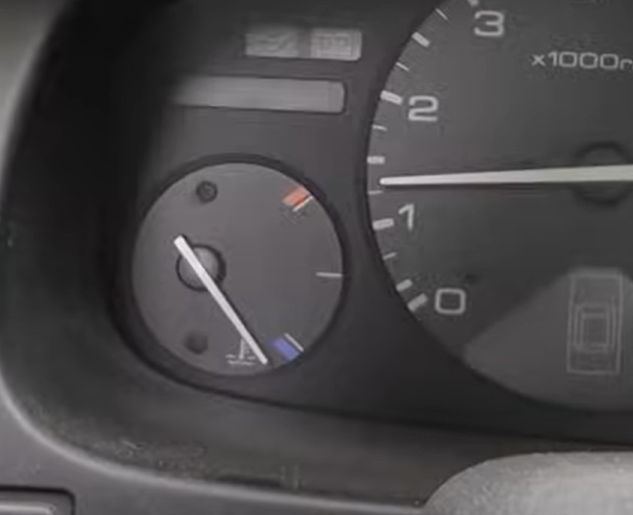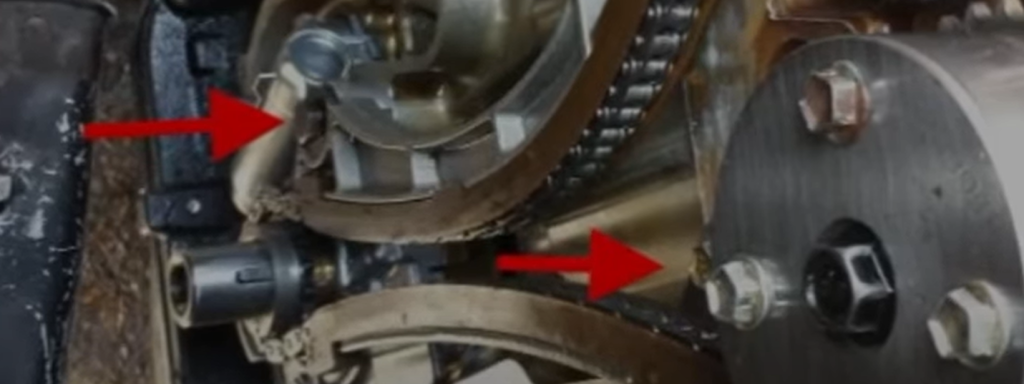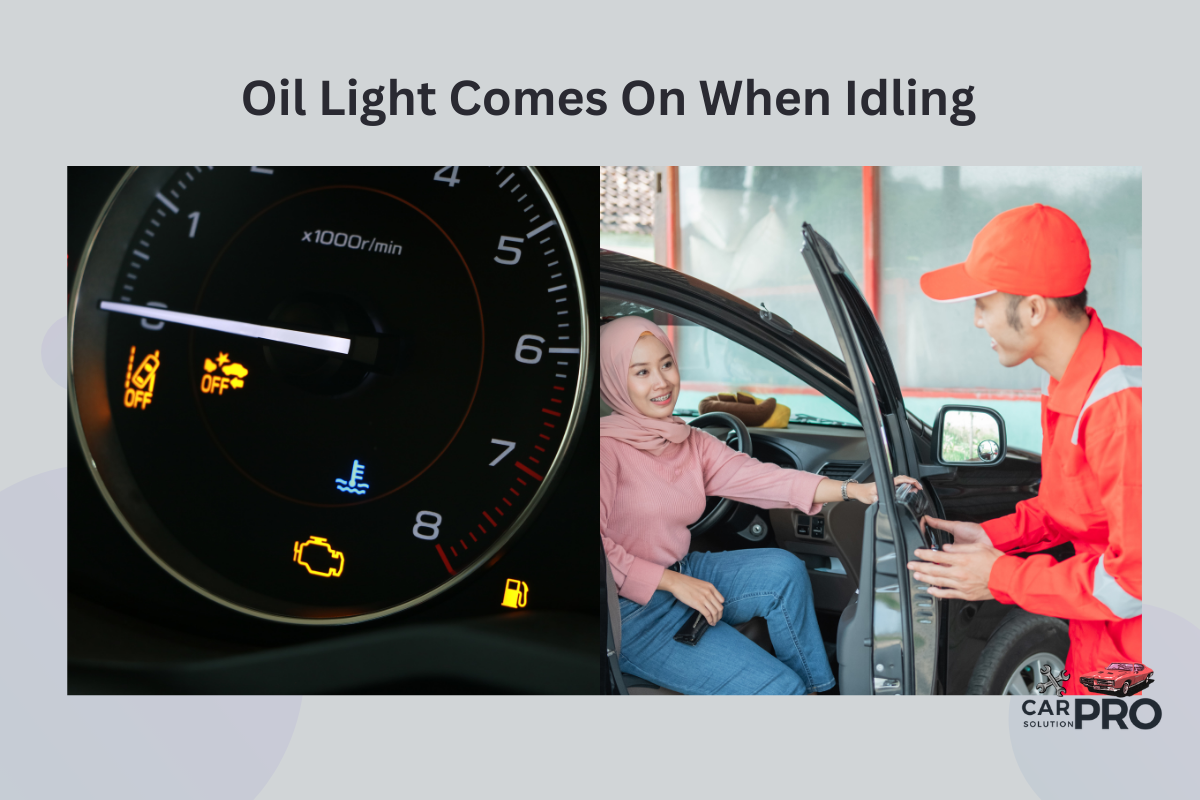The oil light coming on when idling can be a cause for concern. This warning signal indicates a potential issue with your vehicle’s oil pressure or oil level. Low oil pressure at idle is often caused by factors like incorrect oil type, worn-out oil pumps, clogged filters, or engine wear.
When your car is idling, the engine runs at its lowest speed. This can make oil pressure issues more noticeable. The oil light may turn on if the pressure drops below a certain threshold. It’s important to address this problem promptly to avoid engine damage.
Several factors can trigger the oil light at idle. These include low oil levels, worn-out oil, faulty sensors, or a malfunctioning oil pump. Regular maintenance and quick action when the light appears can help prevent costly repairs.
Key Takeaways
- The oil light at idle indicates low oil pressure or level issues
- Causes include worn parts, incorrect oil, or sensor problems
- Prompt action and regular maintenance can prevent engine damage
Understanding the Oil Light Indicator
The oil light indicator is a crucial warning system in your vehicle. It alerts you to potential issues with oil pressure or level that could damage your engine.
Functions of the Oil Light
The oil light serves several key purposes in your car. It turns on briefly when you start the engine to show it’s working. If it stays on or comes on while driving, it warns of low oil pressure.
This can happen due to low oil levels or problems with the oil pump. The light may also flash if oil pressure drops momentarily. Some cars have a separate light for low oil levels.
Regular oil changes help prevent issues. If the light comes on, stop driving and check your oil level right away. Continuing to drive with the oil light on can cause severe engine damage.
Types of Oil Pressure Warning Systems
Cars use different systems to monitor oil pressure. The most basic is a simple on/off switch. It turns the light on when pressure falls below a set point.
More advanced systems use sensors to measure actual pressure. These can give more detailed warnings. Some cars show oil pressure on a gauge instead of just a light.
Digital displays in newer vehicles may show exact pressure readings. They can also give more specific warnings about oil issues.
No matter the system, always take oil pressure warnings seriously. Check your oil level and pressure if the light comes on, especially when idling. Get your car checked by a mechanic if you’re unsure about the cause.
Common Causes for Oil Light Illumination at Idle
The oil light coming on when idling can be due to several issues affecting oil pressure. These range from low oil levels to problems with the engine components. Understanding these causes can help diagnose and fix the problem quickly.
Low Oil Level

A low oil level is often the simplest reason for the oil light to illuminate at idle. When the engine is low on oil, it can’t maintain proper pressure, especially at low speeds. This issue is easy to check and fix.
To check the oil level:
- Park on a level surface
- Wait for the engine to cool
- Locate and remove the dipstick
- Wipe it clean and reinsert
- Remove again to check the level
If the oil is below the minimum mark, add the correct type of oil until it reaches the proper level. It’s important to check oil levels regularly and top up as needed.
Oil Viscosity and Quality Issues
Oil that’s too thin or thick can cause pressure problems. Using the wrong viscosity can lead to inadequate lubrication and pressure drops at idle.
Factors affecting oil viscosity:
- Temperature
- Age of the oil
- Contamination
Old or dirty oil may not flow properly, leading to pressure issues. It’s crucial to follow the manufacturer’s recommendations for oil type and change intervals. Regular oil changes help maintain proper viscosity and prevent contaminants from building up.
Engine Oil Pump Malfunction

The oil pump is responsible for circulating oil throughout the engine. A faulty oil pump can cause low pressure, especially at idle when engine speed is low.
Signs of a failing oil pump:
- Noisy engine
- Higher engine temperature
- Metal shavings in the oil
If the oil pump isn’t working correctly, it may not produce enough pressure at low speeds. This can trigger the oil light. A mechanic can test the pump’s performance and replace it if necessary.
Worn Engine Bearings
Engine bearings support moving parts and need constant lubrication. As bearings wear, they allow more oil to escape, reducing pressure. This effect is most noticeable at idle when oil pressure is naturally lower.
Worn bearings can cause:
- Knocking sounds
- Increased oil consumption
- Metal particles in oil
Bearing wear is a serious issue that requires prompt attention. If left unchecked, it can lead to engine failure. A mechanic can measure bearing clearances and recommend repairs or replacement as needed.
Diagnostic Steps
When the oil light comes on while idling, it’s crucial to diagnose the issue quickly. Follow these steps to find and fix the problem before it leads to engine damage.
Checking Oil Level and Quality
Start by checking the oil level and quality. Park the car on level ground and let it cool down. Locate the dipstick, pull it out, and wipe it clean. Reinsert the dipstick fully, then remove it to check the oil level.
The oil should be between the minimum and maximum marks. If it’s low, add oil to reach the proper level.
Examine the oil’s color and texture. Clean oil is amber. If it’s dark or gritty, it needs changing. Low oil levels or poor quality oil can trigger the oil light.
Inspecting the Oil Pressure Sensor and Circuit
The oil pressure sensor monitors oil pressure and sends signals to the dashboard light. A faulty sensor or wiring can cause false warnings.
Locate the oil pressure sensor near the oil filter. Check for loose connections or damaged wires. Tighten any loose connections.
Use a multimeter to test the sensor’s resistance. Disconnect the sensor and measure between its terminals. Compare the reading to the specs in your car’s manual.
If the sensor tests okay, inspect the wiring harness for damage. Look for frayed wires, corrosion, or loose connections in the circuit.
Manual Oil Pressure Testing
To directly measure oil pressure, use a mechanical gauge. This test confirms if the problem is low pressure or a faulty sensor.
Find the oil pressure sender port, usually near the oil filter. Remove the sender and attach the gauge.
Start the engine and let it idle. Normal oil pressure at idle is typically 5-20 psi. Rev the engine to 2000-3000 rpm. Pressure should increase to 20-50 psi.
Low pressure readings may indicate a worn oil pump, clogged oil passages, or engine bearing problems. High readings could mean a clogged oil filter or passages.
Potential Consequences of Ignoring the Oil Light
Ignoring the oil light can lead to serious problems for your car’s engine. The light warns of issues that need quick attention to avoid costly damage.
Engine Wear and Tear
When the oil light comes on, it often means low oil pressure. This can cause parts to rub against each other without proper lubrication. The engine’s moving parts may start to grind and wear down faster than normal.
Over time, this wear can lead to reduced engine performance. You might notice your car doesn’t run as smoothly or efficiently. The engine may make unusual noises or vibrate more than usual.
Low oil pressure can also cause overheating. This puts extra stress on engine parts, making them more likely to fail early.
Risk of Severe Engine Damage
If left unchecked, low oil pressure can cause major engine damage. The oil light may signal that vital parts aren’t getting the lubrication they need.
In extreme cases, this can lead to complete engine failure. The engine might seize up, leaving you stranded on the road. Fixing a seized engine is very expensive – often costing thousands of dollars.
Ignoring the oil light can also void your car’s warranty. This means you’d have to pay for any repairs out of pocket.
It’s always best to address the oil light as soon as it comes on. This can help prevent costly damage and keep your car running smoothly.
Maintenance and Prevention Strategies
Keeping your car’s oil system in good shape can stop the oil light from coming on when idling. Regular upkeep and quick fixes help avoid bigger problems down the road.
Regular Oil Changes and Monitoring
Checking your oil level often is key to prevent oil light issues. Use the dipstick to check oil levels every few weeks.
Look for the bright-colored dipstick under the hood. Pull it out, wipe it clean, then put it back in. Pull it out again to see where the oil line is.
Change your oil as your car manual says. This is usually every 3,000 to 7,500 miles. Fresh oil keeps the engine running smoothly.
Keep an eye out for oil leaks. If you see dark spots under your car, get it checked out fast.
Using the Correct Oil Grade
Putting in the right type of oil is very important. Your car manual will tell you what oil grade to use.
Using the wrong oil can make the oil light come on when idling. Oil that’s too thin won’t give enough pressure at low speeds.
Check the oil viscosity rating on the bottle. It should match what your car needs. For example, 5W-30 or 10W-40.
Weather can affect which oil to use. Thinner oil works better in cold climates. Thicker oil is good for hot weather.
Timely Repairs and Component Replacement
Fix oil system parts fast when they break. This stops small issues from turning into big, costly problems.
The oil pump is key for oil pressure. If it’s worn out, replace it right away. A new pump will keep oil flowing well.
Clean or replace clogged oil filters. They can block oil flow and cause low pressure when idling.
Check and fix any leaks in oil lines or gaskets. Even small leaks can lead to low oil levels over time.
Keep an eye on engine wear. Worn bearings or other parts can cause low oil pressure. Get them fixed to avoid engine damage.
Frequently Asked Questions
The oil pressure light activating during idle can stem from various issues. Understanding the causes and potential solutions helps drivers address this problem effectively.
What causes the oil pressure light to activate only during idle?
Low oil pressure at idle is a common reason for the light to come on. This can happen due to a worn oil pump or engine bearings. Oil that’s too thin or low oil levels can also trigger the warning light.
Could an oil pressure sensor malfunction cause the light to come on when idling?
Yes, a faulty oil pressure sensor can cause false readings. This may lead to the oil light coming on when idling, even if the actual oil pressure is normal.
Why does the oil light flicker on and off intermittently at low speeds or when stopping?
Flickering oil lights often indicate inconsistent oil pressure. This can be due to clogged oil passages or a failing oil pump. Worn engine bearings may also cause pressure fluctuations.
What should be checked if the oil light illuminates on a 2010 Ford Escape while idling?
First, check the oil level and condition. If these are fine, inspect the oil pressure sensor and wiring. The oil pump and engine bearings may need examination if the issue persists.
Why might the oil light turn off upon acceleration if it comes on during idle?
Oil pressure typically increases with engine speed. A worn oil pump might provide adequate pressure at higher RPMs but struggle at idle. This can cause the light to turn off during acceleration.
Should I be concerned if my oil level is fine but the oil light comes on when the engine is hot?
Yes, this situation warrants concern. It may indicate oil thinning at high temperatures or internal engine wear. Prompt inspection by a mechanic is advisable to prevent potential engine damage.


